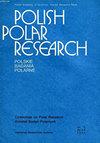Diatom colonization and community development in Antarctic marine waters – a short-term experiment
IF 0.8
4区 地球科学
Q4 ECOLOGY
引用次数: 6
Abstract
: Main aim of the study was to search for possible differences in diatom colonization and their communities under the influence of glacier meltwater inflow and when unaffected by glacier meltwater, and also to define the time needed for the development of diatom communities on newly submerged substrates at small depths in Antarctica. We used artificial substrates (Plexiglass© tiles), submerged at a depth of 1 m below the sea surface at two locations at the South Bay of Livingston Island: (1) Johnsons Dock – a cove, known to receive glacier meltwater with sediments, and (2) outside the cove, generally unaffected by glacial meltwater. Samples from the natural epilithon at similar depth were also taken as a reference for diatom community structure. Statistical testing the differences between the two sites was not possible this time, but the samples allowed us to compare the sites in terms of diatom growth, species richness, diversity and evenness changes in diatom communities along the time of the experiment at both sites and with the natural epilithon at similar depths. Diatom colonization followed the three-phases scheme (colonization, logarithmic growth and equilibrium) as in other latitudes. Based on the valve density and community indices e.g. species richness, diversity (1-D) and evenness (J’), we consider that at least three weeks might be necessary to obtain sufficiently representative for the environment diatom communities on new substrates at small depths in Antarctica, in conditions similar to those of South Bay. No particular differences between the sites were noted in the colonization scheme, but the diversity (1-D) and evenness (J’) were higher at glacier influenced site, as well as the number of the valves on the substrates . Sea ice diatoms prevailed at the glacier influenced site. We suggest that species exchange between the sea ice and other hard substrates do exist, at least for some taxa, and such species might be indicative for variations in both salinity and water transparency, related to glacial meltwater inflow.南极海域硅藻定殖和群落发展-短期实验
本文章由计算机程序翻译,如有差异,请以英文原文为准。
求助全文
约1分钟内获得全文
求助全文
来源期刊

Polish Polar Research
ECOLOGY-GEOSCIENCES, MULTIDISCIPLINARY
CiteScore
2.00
自引率
7.70%
发文量
0
审稿时长
>12 weeks
期刊介绍:
The quarterly Polish Polar Research edited by the Committee on Polar Research of the Polish Academy of Sciences is an international journal publishing original research articles presenting the results of studies carried out in polar regions.
All papers are peer-reviewed and published in English.
The Editorial Advisory Board includes renowned scientist from Poland and from abroad.
 求助内容:
求助内容: 应助结果提醒方式:
应助结果提醒方式:


